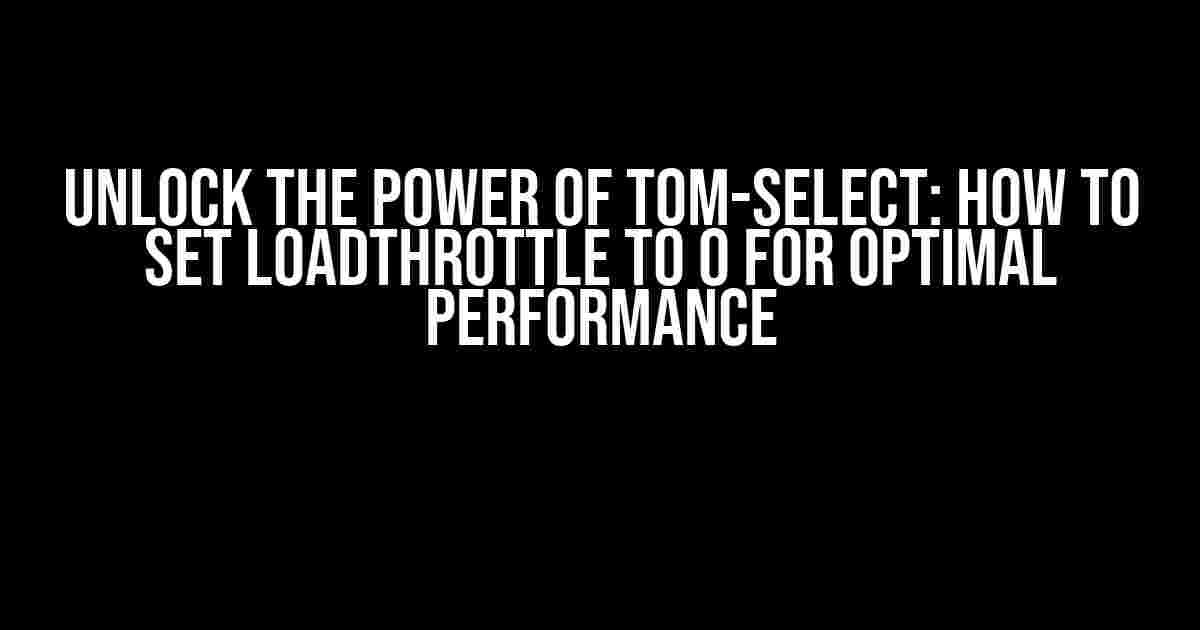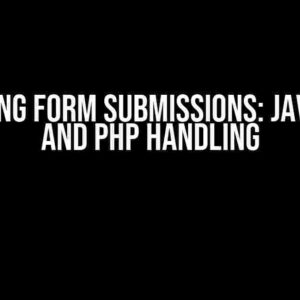When working with tom-select, a popular JavaScript library for select elements, you might have stumbled upon the load() function. This function is essential for populating your select element with data, but did you know that it can be optimized for better performance? In this article, we’ll delve into the world of loadThrottle and explore how to set it to 0 when using the default load() function in tom-select.
What is loadThrottle, and Why is it Important?
loadThrottle is a property in tom-select that controls the frequency of data loading when the user interacts with the select element. By default, loadThrottle is set to 300ms, which means that the library will wait for 300 milliseconds after the user stops typing or interacting with the select element before loading new data. This delay is intended to prevent excessive data loading and improve performance.
However, in certain scenarios, you might want to set loadThrottle to 0, effectively eliminating the delay and allowing for instantaneous data loading. This can be particularly useful when working with small datasets or when you need to provide rapid feedback to the user.
The Default load() Function: A Brief Overview
The load() function in tom-select is responsible for populating the select element with data. When called, it will fetch the data from the specified source and append it to the select element. The default load() function is designed to work seamlessly with tom-select’s plugin architecture, allowing you to customize the data loading process to your heart’s content.
Here’s a basic example of how to use the default load() function:
const select = tomSelect('#mySelect');
select.load('/api/data');In this example, the load() function is called on the select element with the ID “mySelect”, and it fetches data from the “/api/data” endpoint.
Setting loadThrottle to 0: The Step-by-Step Guide
Now that we’ve covered the basics, let’s dive into the meat of the article: setting loadThrottle to 0. There are two ways to achieve this, and we’ll explore both methods in detail.
Method 1: Using the load() Function Options
The first method involves passing an options object to the load() function. This object can contain various properties, including loadThrottle. Here’s an example:
const select = tomSelect('#mySelect');
select.load('/api/data', {
loadThrottle: 0
});In this example, we’re calling the load() function with an options object that sets loadThrottle to 0. This effectively eliminates the delay, and the data will be loaded instantly.
Method 2: Using the init() Function Options
The second method involves setting loadThrottle to 0 during the initialization of the tom-select instance. This approach is useful when you want to set the loadThrottle globally for all load() function calls. Here’s an example:
const select = tomSelect('#mySelect', {
loadThrottle: 0
});
select.load('/api/data');In this example, we’re initializing the tom-select instance with an options object that sets loadThrottle to 0. This means that all subsequent calls to the load() function will use the new loadThrottle value.
Benefits of Setting loadThrottle to 0
Now that we’ve covered the how-to’s, let’s explore the benefits of setting loadThrottle to 0:
- Faster User Experience: By eliminating the delay, you can provide a more responsive user experience, especially when working with small datasets.
- Improved Performance: Reducing the loadThrottle value can lead to better performance, as the library will spend less time waiting for the user to stop interacting with the select element.
- Increased Flexibility: Setting loadThrottle to 0 gives you more control over the data loading process, allowing you to tailor it to your specific use case.
Common Pitfalls and Considerations
While setting loadThrottle to 0 can be beneficial, there are some potential pitfalls to consider:
| Pitfall | Description |
|---|---|
| Excessive Data Loading | With loadThrottle set to 0, the library will load data more frequently, which can lead to increased server load and slower performance. |
| Data Overload | If the user interacts rapidly with the select element, setting loadThrottle to 0 can result in a data overload, leading to slower performance and potential errors. |
| Network Congestion | Frequent data loading can cause network congestion, especially in scenarios where the user has a slow internet connection. |
To mitigate these risks, it’s essential to carefully consider your use case and implement measures to prevent excessive data loading, such as debouncing or implementing pagination.
Conclusion
In conclusion, setting loadThrottle to 0 when using the default load() function in tom-select can be a powerful optimization technique. By understanding how to set loadThrottle and being aware of the potential benefits and pitfalls, you can unlock the full potential of tom-select and create a faster, more responsive user experience.
Remember to carefully evaluate your use case and implement measures to prevent excessive data loading. With these guidelines, you’ll be well on your way to creating high-performance select elements that delight your users.
Happy coding!
Frequently Asked Question
Get the lowdown on setting loadThrottle to 0 when using the default load() function in tom-select!
What is loadThrottle in tom-select, and why do I need to set it to 0?
loadThrottle is a feature in tom-select that limits the frequency of load() function calls to prevent excessive server requests. Setting it to 0 allows you to bypass this throttle and make requests as soon as the user types, which can be useful for certain use cases.
How do I set loadThrottle to 0 when using the default load() function in tom-select?
You can set loadThrottle to 0 by passing an options object with the loadThrottle property set to 0 when initializing the tom-select instance. For example: const tomSelectInstance = new TomSelect(‘#select’, { loadThrottle: 0 });
Does setting loadThrottle to 0 have any performance implications?
Yes, setting loadThrottle to 0 can lead to increased server requests, which may impact performance if your server is not optimized to handle a high volume of requests. Use this setting with caution and ensure your server is equipped to handle the increased load.
Can I set loadThrottle to 0 for a specific instance of tom-select, or does it affect all instances?
You can set loadThrottle to 0 for a specific instance of tom-select by passing the options object with loadThrottle: 0 when initializing that instance. This setting does not affect other instances of tom-select.
Are there any alternative ways to optimize the load() function in tom-select besides setting loadThrottle to 0?
Yes, you can optimize the load() function by implementing debouncing or throttling using libraries like Lodash, or by using tom-select’s built-in caching feature. These approaches can help reduce the number of server requests while still providing a responsive user experience.






